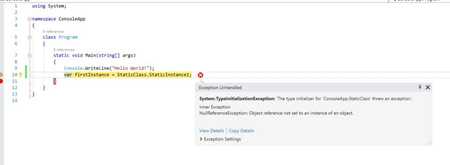Static Initializers in C#: A Cautionary Tale
January 03, 2020
I have been chasing a weird bug in a solution I've been working on. The insight on how certain C# feature work by design, which I got after catching of the culprit, made me write this post in the hope that somebody can save hours or days of debugging.
My solution uses SPMeta2 library to define a structure of a SharePoint site to be provisioned. You specify a collection of "nodes" that represent your lists, content types, site columns and so on. It can be then "provisioned" on the target side using CSOM or SSOM.

Static Function (yes, it's PHP but it gets the point, right?)
The structure was defined using static properties on static classes such as FieldDefinitions.cs or ContentTypeDefinitions.cs. A new content type, for instance, would be defined as a ContentTypeDefinition property initialized inline with a static initializer.
public static ContentTypeDefinition BaseContentType = new ContentTypeDefinition()
{
Name = "BaseContentType",
Id = new Guid("EC0463EA-2AA1-4461-8407-2A4D0FD58B8B"),
ParentContentTypeId = BuiltInContentTypeId.Document,
Group = GroupNames.MyContentTypeGroupName
};
However, when I retrieved a template (a sum of all ModelNodes in the definition) I would get a weird System.TypeInitializationException in the nodes collection.

The source of my headache for a couple of days (simplified)
I spent a couple of days trying to find the root of the issue. As I couldn't debug static initializers, I had to rely on removing and adding nodes to see what triggers the error. Finally I got it.
The offending code was like this:
public static class ContentTypeDefinitions
{
public static ContentTypeDefinition ContentType1 = new ContentTypeDefinition()
{
Name = "ContentType1",
...
ParentContentTypeId = ContentTypeDefinitions.ContentType2.Id
};
public static ContentTypeDefinition ContentType2 = new ContentTypeDefinition()
{
Name = "ContentType2",
...
ParentContentTypeId = BuiltInContentTypeId.Document
};
...
}
Do you see the error?
ContentType1 (a static field) relies on the ContentType2 definition (another static field) to be initialized. However, ContentType2 is defined AFTER the ContentType1 in the source code. But, since when the order of definitions in C# is important? Shouldn't the strongly-typed nature of C# make it irrelevant?
As per C# specifications, section 10.11 Static Constructors says:
If a class contains any static fields with initializers, those initializers are executed in textual order immediately prior to executing the static constructor.
C# 1.2 Language Specification, section 10.11 paragraph 7.
I fixed the code just by reordering the static fields:
public static class ContentTypeDefinitions
{
public static ContentTypeDefinition ContentType2 = new ContentTypeDefinition()
{
Name = "ContentType2",
...
ParentContentTypeId = BuiltInContentTypeId.Document
};
public static ContentTypeDefinition ContentType1 = new ContentTypeDefinition()
{
Name = "ContentType1",
...
ParentContentTypeId = ContentTypeDefinitions.ContentType2.Id
};
...
}
And it just works.
If you want to see it by yourself, this is a minimal demo that makes the error. You can run it inside DotNetFiddle.
As soon as the order of static fields is reversed, it works.